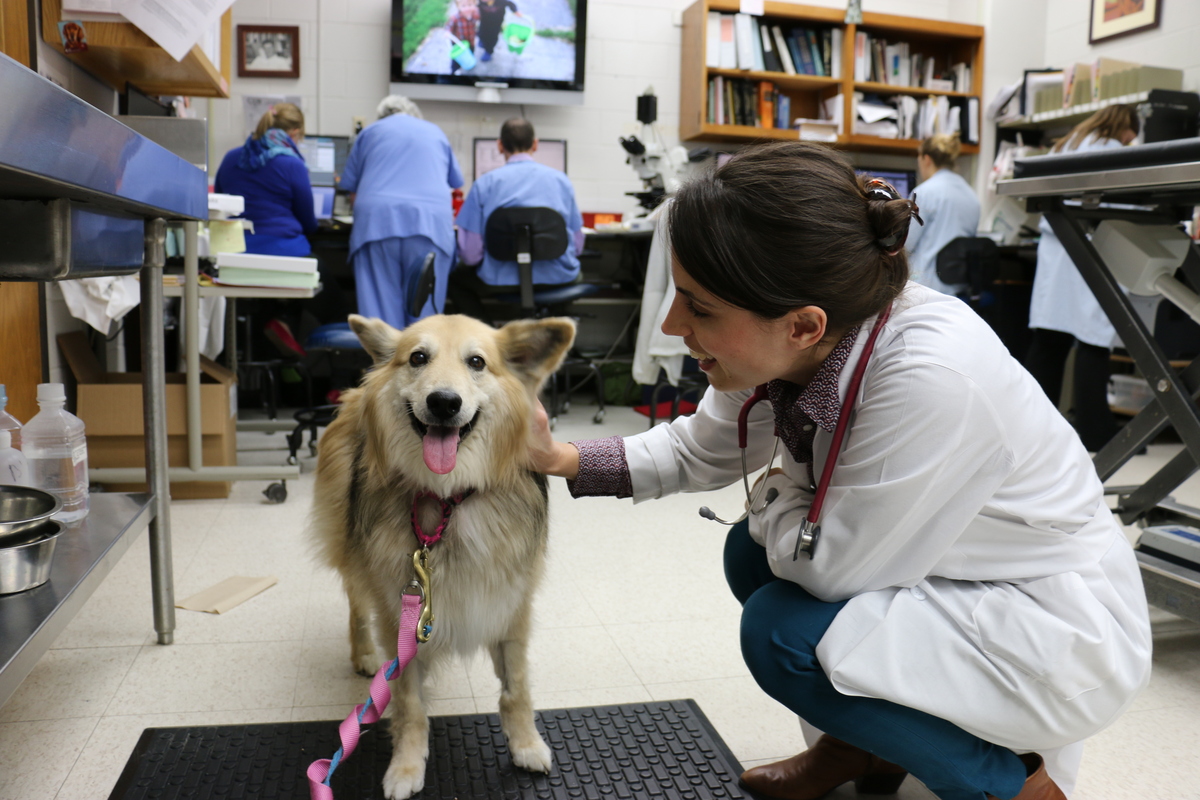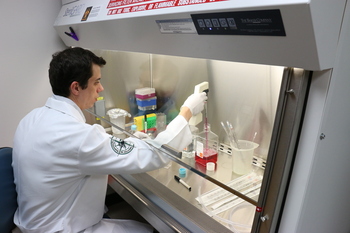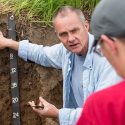Study reveals possible biological trigger for canine bone cancer

UW-Madison School of Veterinary Medicine intern Kathleen Tsimbas checks on Yurtie, a canine cancer patient, in the UW Veterinary Care oncology ward.
Photo: Nik Hawkins
Researchers at the University of Wisconsin–Madison School of Veterinary Medicine (SVM) have identified the biological mechanism that may give some cancer cells the ability to form tumors in dogs.
The recent study uncovered an association between the increased expression of a particular gene in tumor cells and more aggressive behavior in a form of canine bone cancer. It may also have implications for human cancers by detailing a new pathway for tumor formation.
The findings, published online this month in the journal Veterinary and Comparative Oncology, may eventually provide oncologists with another target for therapy and improve outcomes for canine patients with the disease.
The findings … may eventually provide oncologists with another target for therapy and improve outcomes for canine patients.
The researchers examined cell lines generated from dogs with osteosarcoma, a common bone cancer that also affects people, with the intent of uncovering why only some cells generate tumors. After the dogs underwent tumor-removal surgery at UW Veterinary Care — the SVM’s veterinary medical teaching hospital — cells from the tumors were grown in the lab.
This led to six different cancer cell lines, which were then transplanted into mice. The researchers then looked to see which lines developed tumors and which did not and studied the differences between them.
“We found several hundred genes that expressed differently between the tumor-forming and nontumor-forming cell lines,” says Timothy Stein, an assistant professor of oncology. However, one protein called frizzled-6 was present at levels eight times higher in cells that formed tumors.
In the complicated process of gene expression, the genetic information encoded within DNA is eventually converted into RNA and proteins, which are responsible for a variety of vital cellular functions. Frizzled-6 plays a key role in relaying signals from the outside to the inside of a cell, acting as a sort of receiving dock for particular types of information.
Molecular connections like this activate pathways, some of which regulate the growth, differentiation and migration of cells when working properly. But when pathways go awry, they may contribute to the development of tumors and tumor-initiating cells. The role of frizzled-6 in this process is not yet fully understood.
“It’s exciting because it’s kind of uncharted territory,” says Stein, who is also a member of the UW Carbone Cancer Center. “While we need more research to know for sure, it’s possible that frizzled-6 expression may be inhibiting a particular signaling pathway and contributing to the formation of tumor-initiating cells.”

Lucas Rodrigues, lead author on the canine bone cancer study, replaces a culture medium in which cancer cells are grown.
The study is a good example of how work at UW Veterinary Care can lead to a better understanding of disease, Stein says, and it highlights how basic science can be a bridge to clinical research.
“Now I’d like to see what this means clinically,” he says. “Does frizzled-6 serve as a marker of a more aggressive disease? Will it help us improve the accuracy of our prognoses? These are the questions we want to answer.”
Stein also hopes to continue this line of research in human cancer patients. Meanwhile, the lead author on the study, Lucas Rodrigues, is continuing the investigation in dogs.
“Now we want to make sure that frizzled-6 is truly what gives these cells the ability to form new tumors,” says Rodrigues, a postdoctoral fellow in Stein’s lab.
While frizzled-6 may be the lone culprit, it is possible that a combination of multiple genes may lead to tumor formation, says Rodrigues.
The study was also co-authored by Victoria Thompson, an associate research specialist; Katie Holmes, a 2014 graduate of the Doctor of Veterinary Medicine program; and Michael Newton, a professor in the Departments of Statistics and Biostatistics and Medical Informatics.


